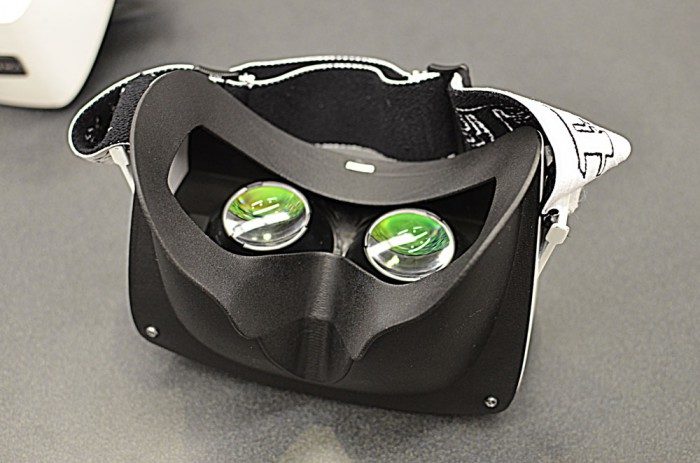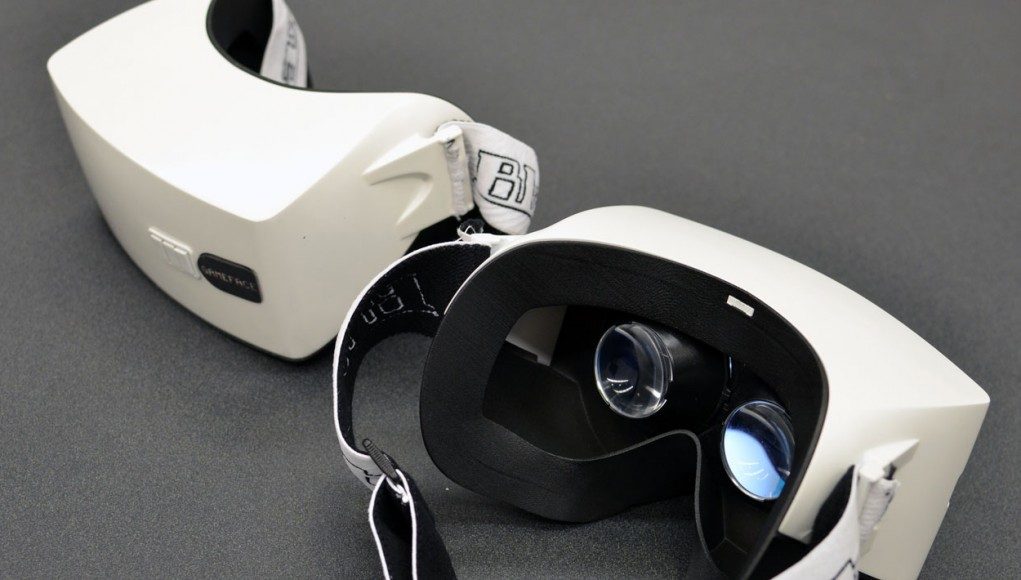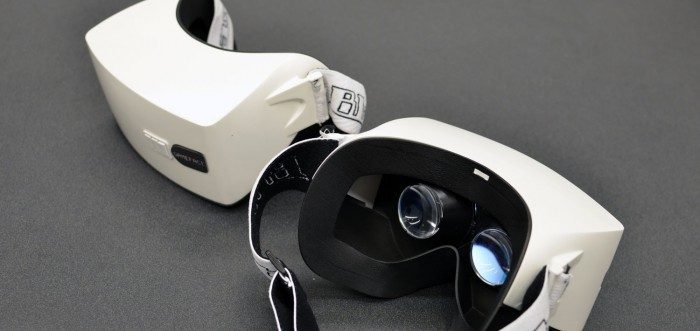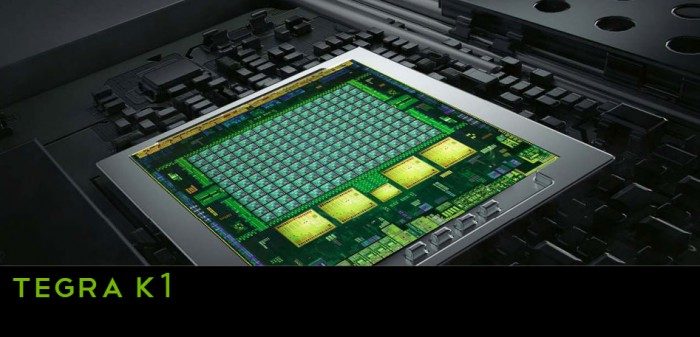GameFace Labs may very well be the furthest along in the quest to create a mobile VR headset. Based on Android, GameFace Labs has been working hard to iterate on their prototypes, their latest is the first VR headset (mobile or tethered) to include a 2.5K display, with 78% more pixels than 1080p based VR headsets like the Oculus Rift DK2. And they’ve got even more surprises up their sleeve.
Update (4/8/14, 6:14PM): All references to “2K” have been updated to “2.5K” to more accurately represent the resolution of the display.
Continue Original Article:
If you ever see a tall guy dressed in a suit, strapping a white VR headset to every face he can find, you’ve almost certainly stumbled upon GameFace Labs CEO, Ed Mason. You’ll know for sure when you hear the U.K. accent.
Every trade show I’ve been to in the last 6 months has had one consistent factor—Mason hustling the venue with seemingly unstoppable energy. With two of the company’s unmistakable white GameFace prototypes, he prowls the shows, spreading the good word of mobile VR. And he has good reason; GameFace Labs may very well be the furthest along in the quest to create a truly useable mobile VR headset.
2.5K (1440p) Comes to VR

The latest milestone in that race has been crossed first by GameFace. The company is the first to show off a prototype equipped with a 2.5K display, shown for the first time last night at the VRLA Meetup.
The display is, of course, from an unspecified manufacturer (screen makers love their secrets), but what we do know is that it’s a 5.5-inch panel with a resolution of 2560 x 1440 (~534 PPI). It’s an LCD display, but I’m told that GameFace is targeting low-persistence down the road.
“The upgrade to 1280 x 1440 per eye is monumental. Individual pixels are hard to detect at first glance, making it a more immersive and comfortable experience in every single game and experience that we’ve tried,” Mason told me. “A lot of the ‘presence’ described by devs at the Valve [prototype VR headset] demonstration can be attributed to their use of higher resolution (and lower persistence) panels, which has a noticeable impact in suspending disbelief and tricking the brain.”
Mason says that he and his colleagues are in agreement that a 2.5K display will be the “entry-level requirement for HMD manufacturers entering consumer VR …” The company says they expect to use something similar in their forthcoming dev kit.
And while the lenses on their early prototypes were lifted from the Oculus Rift DK1, Mason tells me that new lenses and much more will debut with their latest prototype…
Next GameFace Prototype to Use Nvidia K1/Jetson “Super Chip”
GameFace Labs isn’t stopping at 2.5K. They’re also working to source the most powerful mobile hardware they can get their hands on. The two white prototypes that Mason has been touting around as of late are based on the Snapdragon 800 and Tegra 4 platforms. I’ve tried both, and they work. But Mason and Co. are on a quest for more power, and they’ve got it now with one of the most powerful mobile chips available.
The Tegra K1 (also known as ‘Jetson’) is a SoC (system-on-a-chip) that combines a quad-core ARM Cortex CPU (up to 2.3GHz) with a 192-core GPU. And if GameFace want to push the resolution even higher, K1 supports up to a 3840 x 2160 LCD. Nvidia calls it the “world’s most advanced GPU,” part of that claim coming from the fact that it can run Unreal Engine 4 along with DX11 support…. all at 5 watts.
And this isn’t just a “we plan to use the K1” sort of thing… Mason has sent me photos of the K1 board that the company is now building into its latest prototype, which it intends to show at Penguicon early next month where they’re being awarded the ‘Hack of Honor 2014’.
Better Every Time I See It
 I’ve had the opportunity to try GameFace’s prototypes on several occasions, and each time I have, the experience has improved. It’s freeing and intuitive to have a mobile VR headset where you can let the rotation of your body determine the direction of your virtual self. The same can’t be done with tethered VR headsets like the Oculus Rift—where you generally always face the same direction, but use some form of unnatural input to rotate your virtual self—simply because you’d get tangled up in the cord.
I’ve had the opportunity to try GameFace’s prototypes on several occasions, and each time I have, the experience has improved. It’s freeing and intuitive to have a mobile VR headset where you can let the rotation of your body determine the direction of your virtual self. The same can’t be done with tethered VR headsets like the Oculus Rift—where you generally always face the same direction, but use some form of unnatural input to rotate your virtual self—simply because you’d get tangled up in the cord.
In addition to hardware, the company might be the furthest along when it comes to mobile VR content. At GDC 2014, Mason showed me a Dreamcast emulator running on the GameFace prototype. I was playing the cult-classic Jet Set Radio (2000), and to my amazement, they’ve actually natively expanded the field-of-view to create an immersive experience. They’ve also worked with Nick Pittom, developer of the Spirited Away VR experience, to bring that scene to the unit. This is in addition to a myriad of other demos, like several 360 degree video experiences which are surprisingly immersive.
Every time I see Mason, he’s got some new content to show me. And one of the reasons I’m rooting for GameFace is that their pursuit could jumpstart the rest of the mobile VR world. Surely many of you have seen any of the numerous smartphone HMD adapters like VRase, Altergaze, and Durovis Dive (even VRelia is working on one). All of these work by sliding a smartphone into a housing and using its display and other hardware as the basis for a VR headset. But they all share a common problem… there’s hardly any content available. GameFace Labs seems well on the way to changing that, and because their product is Android-based, much of the content may be cross compatible with smartphone HMD adapters.
Mason tells me that the latest GameFace SDK significantly reduces latency to a point that it is “easily comparable to the DK1.” The company plans to benchmnark their latency soon to get a quantitative latency figure. The GameFace SDK, which doesn’t require Unity Pro, is available to any developer who wants to reach out to GameFace Labs (info@gamefacelabs.com).
GameFace Early-bird Dev Kit and Future
 GameFace is hoping to bring a dev kit of their mobile VR headset to market by the end of this year. Starting today, you can sign up at the GameFace Labs site to get in line for an early-bird unit, available one month before the general release (see the button at the top right). There’s no word so far on what the unit might cost, but my guess is that it will be more expensive than comparably speced tethered HMDs, given that it has to have all of the hardware on board. It will be interesting to see, however, when the cost of a powerful gaming computer is added to the equation, which one ends up being cheaper….
GameFace is hoping to bring a dev kit of their mobile VR headset to market by the end of this year. Starting today, you can sign up at the GameFace Labs site to get in line for an early-bird unit, available one month before the general release (see the button at the top right). There’s no word so far on what the unit might cost, but my guess is that it will be more expensive than comparably speced tethered HMDs, given that it has to have all of the hardware on board. It will be interesting to see, however, when the cost of a powerful gaming computer is added to the equation, which one ends up being cheaper….
GameFace Labs, which is based in the U.K. has shared with Road to VR that the company recently secured an unspecified amount of funding, apparently enough to expand operations into the U.S. and hire some SoC engineers. Given their head start, I’d be surprised if an interested company looking to get a jump on mobile VR doesn’t swoop in and scoop up GameFace Labs in the near future.
There’s a good chance we’ll be seeing GameFace’s latest 2.5K + K1 prototype for ourselves next month. Stay tuned.









